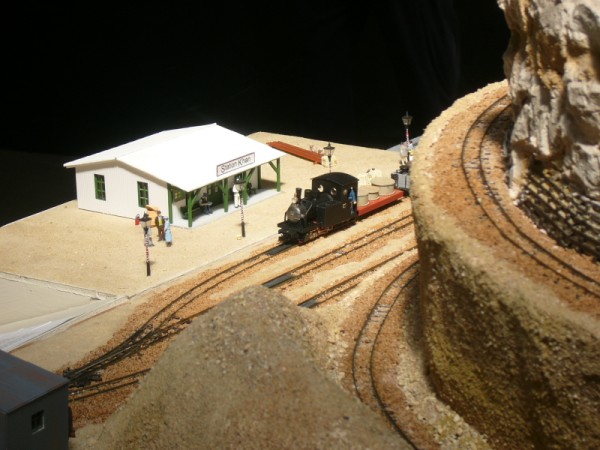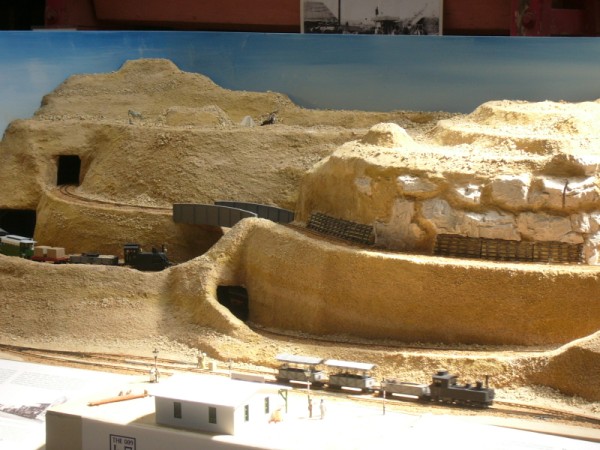

 The layout was started in 2005 and is the first one I have built for about 30 years. My previous efforts went into a box while I went out into the world and discovered travelling, women, etc., but always retained an interest in railways. At the beginning of 2003 we (wife, 2 children, me) returned to the UK after 5 excellent years in South Africa. The scenery, the animals and the people were fantastic as was the railway photography. In contrast the UK seemed a bit 'grey', so I decided I wanted a bit of Africa at home, but which bit? We had a marvellous holiday in Namibia and I picked up some books (there aren't many) on the railways, notably Namib Narrow Gauge by Moir and Crittenden. One photo of a station called Khan, which looked like the surface of the moon, did it - Khan it would be.
The layout was started in 2005 and is the first one I have built for about 30 years. My previous efforts went into a box while I went out into the world and discovered travelling, women, etc., but always retained an interest in railways. At the beginning of 2003 we (wife, 2 children, me) returned to the UK after 5 excellent years in South Africa. The scenery, the animals and the people were fantastic as was the railway photography. In contrast the UK seemed a bit 'grey', so I decided I wanted a bit of Africa at home, but which bit? We had a marvellous holiday in Namibia and I picked up some books (there aren't many) on the railways, notably Namib Narrow Gauge by Moir and Crittenden. One photo of a station called Khan, which looked like the surface of the moon, did it - Khan it would be. The railway (600mm gauge) was built between 1898 and 1902 by the German colonial authorities and covered 380km while going from sea level at Swakopmund to Windhuk (now Windhoek) at around 1600m. The real Khan is set by the crossing of a river that flows, nominally, once per 100 years (though, of course, it did wipe out the railway twice in the first five years). The climb away from the river was a long gradient at 1 in 25 which very severely hampered operations; with the first locomotives one loco could only handle one bogie wagon. This was never satisfactory. An uprising by the local Herero people, who, unsurprisingly, took a dim view of being occupied, proved the case finally. The section from Khan had to be rebuilt or replaced. In reality, a long parallel railway was built further to the north by a mining company (OMEG) and this replaced the section through Khan (and rendered about 190km of the line more or less redundant by 1910). In my model this did not happen and a substantial rebuild involving some tunnelling took place above Khan to gain the necessary height on a more favourable gradient.
So now I had my location, my period (1908), my scale (OO9 – after meeting the SNGMs group) and my story. Because the style of layout I was contemplating involveD multiple levels, the design effort was quite challenging. However it is made much easier by using a PC design package. I used XTrkCad which helped enormously with sorting out vertical clearances and minimum radii and I am very grateful to the designer of this piece of freeware. A little bit of maths was involved but mostly trial and a lot of error. Finally, on the sixth version, Khan was designed. Dotted lines represent track in tunnels, though, as built, these are not quite in the same place. The circular track right of centre is a three-and-a-quarter turn hidden spiral which brings the track back from the highest point to the beginning again.
The baseboard for this layout was obviously going to be complex and way beyond my pathetic woodworking skills. Happily I was able to get some real professionals at Magrathean Models to build it for me for a very reasonable price. They were really helpful and produced an excellent job as I hope you can see. Track is Peco 009. I cut and laid cork as track underlay and then pinned the track to that, breaking many mini-drill bits in the process as the MDF is a lot tougher than the Peco track pins. For the spiral I used Peco N gauge Settrack to avoid having to make joints in flextrack on tight curves. This is placed on foam underlay and simply glued down. As the spiral is hidden the different sleeper spacing between 009 and N gauge is not important.
The layout splits in two very unequal halves. To make the join I put two brass screws at the edge of the board under where the track would go. I then laid the track over the join, adjusted the height of the screw until it touched the bottom of the rail and then soldered the rail to the screw. Finally a slitting disk was used to cut the rail. Khan is wired for DC with a Morton Vector Twin Controller, each section being switchable from one controller to the other. Points are electrically operated using passing contact switches. The wiring took a long time and I was amazed to find how much wire it took (120 metres), but was a curiously enjoyable phase of building.
Building the scenery caused me the most heartache and took the most time. I found it very difficult to translate what I had in my head into something on the ground. I had found a Model Railroader publication called Mountain to Desert by Pelle Soeborg - a wonderful modeller in my opinion. For those who haven't come across this book, look at http://www.soeeborg.dk/photogallery.html for a taste of the kind of scenery I was looking for ('The Narrows', 'Donner River Pass').
The recommended method is to use foam insulation board which I got from a company called Sheffield Insulations. Unfortunately I was completely unable to match the very neat finish shown in the book and this led to a lot of frustration. My first aim was to get a smooth surface on the foam. I used Modroc to do this then tried to get a textured surface by covering the surfaces with Scupltamold. Looking back I could have omitted the Modroc as the Sculptamold was satisfactory in filling gaps in the blue foam surface. In mixing up the Sculptamold I used brown poster paint to avoid a pure white effect underneath the ground cover. To form the final cover I used the methods in Pelle Soeborg's book of putting different colours and textures of scatter material on a piece of stiff card and blowing it onto the surface which had been painted with dilute PVA glue.
The main buildings (station) and engine shed have been built using the techniques described Alan Downes in Railway Modeller in the mid 70s, i.e. a stiff card base onto which other material are laminated, in this case plasticard moulded to look like corrugated iron. I have quite a few pictures of the station and some drawings of similar buildings so making up plans was not difficult. The engine shed was much harder as I have not found a picture of anything except the roof. Again reference to similar buildings, e.g the workshops at Karibib, was used to try to get the general feel right.
Most of the human figures are also whitemetal from a large variety of sources picked up at shows in the last few years, my favourites coming from Dart Castings. I really enjoyed painting them using the techique of painting the figure black, then dry brushing in white and stain painting with appropriate colours (all acrylics).
Finally I come to the animals which I wanted to be appropriate for the area and also to be placed in a way that seems true to life. Hence there is group of Gemsbok (also known as Oryx) and Hartmann's Mountain Zebra together and a herd of Springbok on the dry river bed. Up in the rocks you can find Cape Hare, Black-backed Jackals and Klipspringer. Apart from the zebra (Preisler) these are adapted from normal European animals from Preisler, Noch and Dart Castings (again) and repainted. I have to say that some of the models of 'wild' animals on the market are not very good!
The locomotives are based on commercial chassis, either Fleischmann 0-8-0Ts or Bachmann diesel shunters (for the locos with sand shields). The building method is that used by John Thorne (see his layouts elsewhere on this website for inspiration) and involves building a footplate from plasticard then using plasticard sheet and tube for the boiler etc. Fittings are either home made from wire and plastic section or from a variety of manufacturers. The wagons are either scratchbuilt on Microtrains bogies or Parkside Dundas kits. I have tried to give the open wagons and flats appropriate loads for the period and these again come from lots of different manufacturers. The first class coaches are converted Liliput, also on Microtrains bogies.

© 2009 SNGMs